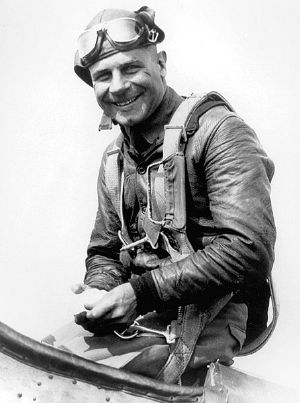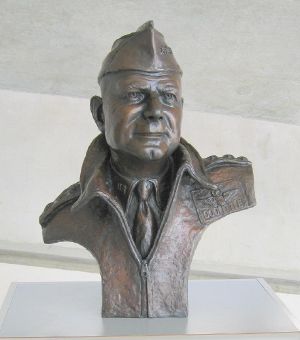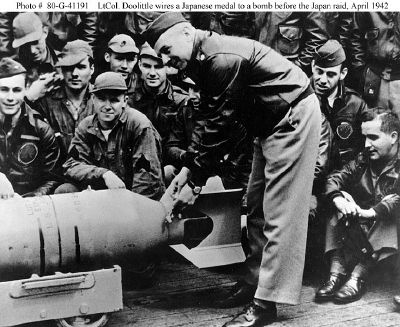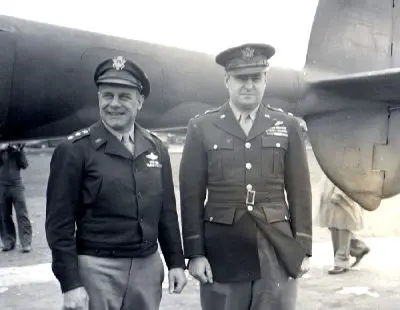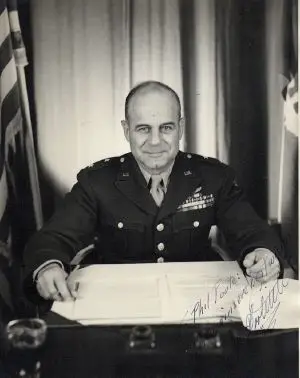Jimmy Doolittle
| James Harold Doolittle | |
|---|---|
| December 14 1896 – September 27 1993 (aged 96) | |
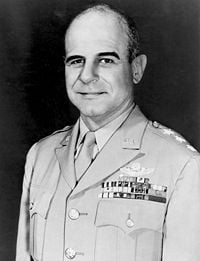 Lt Gen. James Doolittle | |
| Nickname | "Jimmy" |
| Place of birth | Alameda, California |
| Place of death | California |
| Place of burial | Arlington National Cemetery |
| Allegiance | |
| Service/branch | United States Army Air Forces |
| Years of service | 1917–1959 |
| Rank | General (advanced in rank in 1985) |
| Battles/wars | World War II Doolittle Raid |
| Awards | Medal of Honor Distinguished Service Medal (2) Silver Star Distinguished Flying Cross (3) Air Medal (4) |
| Other work | Shell Oil, VP, Director Space Technology Laboratories, Chairman |
General James Harold "Jimmy" Doolittle, USAF (December 14, 1896 – September 27, 1993) was an American aviation pioneer. Doolittle served as a Brigadier general, Major general and Lieutenant general in the United States Army Air Forces during the Second World War.
Although convinced that the airborne attack he led against Japan in April 1942 was in that moment a failure, and that he would face court-martial upon his return to the United States, Doolittle was awarded the Medal of Honor for his valor and leadership as commander of the raid against Tokyo, Japan that came to be known as the Doolittle Raid.
Doolittle was an adventurer at heart who spent time as a miner in California, a prizefighter, an aerial-show "aerobat" and a test pilot. He was the first aviator to fly cross-country in under 24 hours (in 1922) and the first to fly blind, using only his plane's instruments. He won numerous speed trophies, was awarded many medals, and commanded three Air Force groups during the war.
After the war he was active in the reorganization of the American defense establishment and became director of several companies in the private sector.
Early years
Doolittle was born in Alameda, California, and spent his youth in Nome, Alaska, where he earned a reputation as a boxer. He attended Los Angeles City College after graduating from Manual Arts High School in Los Angeles, and later won admission to the University of California, Berkeley where he studied in the School of Mines.
Doolittle took a leave of absence in October 1917 to enlist in the Signal Corps Reserve as a flying cadet; he trained at the University of California School of Military Aeronautics at Rockwell Field, California, and was commissioned a second lieutenant in the Signal Corps' Aviation Section on March 11, 1918. During World War I Doolittle stayed in the United States as a flight instructor and performed his war service at Camp John Dick Aviation Concentration Camp ("Camp Dick"), Texas; Wright Field, Ohio; Gerstner Field, Louisiana; Rockwell Field, California; Kelly Field, Texas; and Eagle Pass, Texas.
Doolittle's service at Rockwell Field consisted of duty as a flight leader and gunnery instructor. At Kelly Field he served with the 104th Aero Squadron and served with the 90th Aero Squadron at Eagle Pass. The latter duty included the Border Patrol that had started prior to the Mexican Punitive Expedition of 1916, and which was turned over to the Department of the Treasury in 1921.
Qualifying for retention at the end of the war, 2nd Lieutenant Doolittle received a Regular Army commission, and was promoted to 1st Lieutenant on July 1, 1920. Subsequently, he attended the Air Service Mechanical School at Kelly Field and the Aeronautical Engineering Course at McCook Field, Ohio.
Having at last returned to complete his college degree, he earned the Bachelor of Arts from the University of California, Berkeley in 1922, and joined the Lambda Chi Alpha Fraternity.
Aviation pioneer
Doolittle was one of the most famous pilots during the inter-war period. In September 1922, he made the first of many pioneering flights, flying a DeHavilland DH-4 - which was equipped with early navigational instruments - in the first cross-country flight, from Pablo Beach, Florida, to Rockwell Field, San Diego, California, in 21 hours and 19 minutes, making only one refueling stop at Kelly Field. The U. S. Army awarded him the Distinguished Flying Cross.
In July 1923, after serving as a test pilot and aeronautical engineer at McCook Field, Doolittle entered the Massachusetts Institute of Technology (MIT). In March 1924, he conducted aircraft acceleration tests at McCook Field, which became the basis of his master's thesis and led to his second Distinguished Flying Cross. He received his S.M. in Aeronautics from MIT in June 1924. Since the Army had given him two years to get his degree and he had done it in only one, he immediately started working on his Sc.D. in Aeronautics, which he received in June 1925.
Following graduation, Doolittle attended special training in high-speed seaplanes at Anacostia Naval Air Station in Washington, D.C.. He also served with the Naval Test Board at Mitchel Field, New York, and was a familiar figure in air speed record attempts in the New York area. He won the Schneider Cup race in a Curtiss R3C in 1925 with an average speed of 232 mph. As a result Doolittle was awarded the Mackay Trophy in 1926.
In April 1926, Doolittle was given a leave of absence to go to South America to perform demonstration flights. In Chile, he broke both ankles, but put his P-1 Hawk through aerial maneuvers with his ankles in casts. He returned to the United States, and was confined to Walter Reed Army Hospital for his injuries until April 1927. Doolittle was then assigned to McCook Field for experimental work, with additional duty as an instructor pilot to the 385th Bomb Squadron of the Air Corps Reserve. During this time, he was the first to perform an outside loop.
Instrument flight
Doolittle's most important contribution to aeronautical technology was the development of instrument flying. In 1929, he became the first pilot to take off, fly, and land an airplane using instruments alone, without a view outside the cockpit. Returning to Mitchel Field that September he assisted in the development of fog flying equipment. He helped develop the now universally used artificial horizon and directional gyroscope and made the first flight completely by instruments. He attracted wide newspaper attention with this feat of "blind" flying and later received the Harmon Trophy for conducting the experiments. These accomplishments made all-weather airline operations practical.
In January 1930, he advised the Army on the building of the Floyd Bennett Field in New York City. Doolittle resigned his regular commission on February 15, 1930 and was commissioned a major in the Specialist Reserve Corps. Soon afterwards he was named manager of the Aviation Department of Shell Oil Company, where he conducted numerous aviation tests. He also returned to active duty with the Army frequently to conduct tests.
Doolittle helped influence the Shell Oil Company to produce the first quantities of 100 octane aviation gasoline. High octane fuel was crucial to the high-performance planes that were developed in the late 1930s.
In 1931, Doolittle won the Bendix Trophy Race from Burbank, California, to Cleveland, Ohio, in a Laird Super Solution Biplane.
In 1932, Doolittle set the world's high speed record for land planes at 296 miles per hour in the Shell Speed Dash. Later, he took the Thompson Trophy Race at Cleveland in the notorious Gee Bee R-1 racer with a speed averaging 252 miles per hour. After having won the three big air racing trophies of the time, the Schneider, Bendix, and Thompson, he officially retired from air racing stating, "I have yet to hear anyone engaged in this work dying of old age."
In April 1934, Doolittle became a member of the Baker Board. Chaired by former Secretary of War Newton D. Baker, the board was convened during the Air Mail Scandal to study Air Corps organization. A year later, Doolittle transferred to the Air Corps Reserve. In 1940, he became president of the Institute of Aeronautical Science. He returned to active duty July 1, 1940 as a major and assistant district supervisor of the Central Air Corps Procurement District at Indianapolis, Indiana, and Detroit, Michigan, where he worked with large auto manufacturers on the conversion of their plants for production of planes. The following August, he went to England as a member of a special mission and brought back information about other countries' air forces and military buildups.
The Doolittle Raid
Shortly after the Japanese attack on Pearl Harbor on December 7, 1941, and America's entry into World War II, Doolittle was recalled to active duty. He was promoted to Lieutenant Colonel on January 2, 1942, and assigned to the United States Army Air Forces Headquarters to plan the first retaliatory air raid on Japan. He volunteered for and received General H. H. (Hap) Arnold's approval to lead the top-secret attack of 16 B-25 medium bombers from the aircraft carrier USS Hornet, with targets in Tokyo, Kobe, Yokohama, Osaka, and Nagoya.
On April 18, 1942 each of the bombers successfully took off from the flight deck of the Hornet, reached Japan, bombed their targets, and headed for their recovery airfield in China. As did most of the other crewmen who participated in the mission, Doolittle's crew bailed out safely over China when their bomber ran out of fuel. By then they had been flying for about 12 hours, it was nighttime, the weather was stormy, and Doolittle was unable to locate their landing field. He parachuted safely into a rice paddy near Chuchow (Quzhou). He and his crew linked up after the bailout and were helped through Japanese lines by Chinese guerrillas and American missionary John Birch. Twelve other aircrews had similar experiences. One aircrew opted to fly into Russia and upon a safe landing, their airplane was confiscated and the crew interned. The crew later returned to the United States through Iran more than one year later in May, 1943 [1] Two other aircrews were not so fortunate.
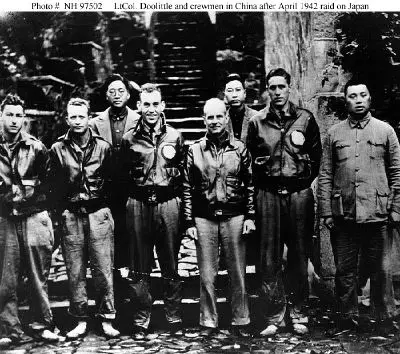
Although most eventually reached safety with the help of friendly Chinese, the sixth and sixteenth aircrews were captured by the Japanese. Three of the eight surviving crew members were executed and the rest interred as prisoners of war for the duration. The Japanese military began the Zhejiang-Jiangxi Campaign to intimidate the Chinese from helping downed American airmen. The Japanese killed an estimated 250,000 civilians while searching for Doolittle's men. [2]
Immediately following the raid, Doolittle told his crew that he believed the loss of all 16 aircraft, coupled with the relatively minor damage the aircraft had inflicted on their targets, had rendered the attack a failure, and that he expected a court-martial upon his return to the United States.[3] Instead, the raid bolstered American morale to such an extent that Doolittle was awarded the Medal of Honor and was promoted two grades to brigadier general, skipping the rank of colonel.
Doolittle received the Medal of Honor from President Franklin D. Roosevelt at the White House for planning and leading his raid on Japan. His citation reads:
For conspicuous leadership above and beyond the call of duty, involving personal valor and intrepidity at an extreme hazard to life. With the apparent certainty of being forced to land in enemy territory or to perish at sea, Lt. Col. Doolittle personally led a squadron of Army bombers, manned by volunteer crews, in a highly destructive raid on the Japanese mainland.[4]
The Doolittle Raid is viewed by historians as a major morale-building victory for the United States. Although the damage done to Japanese war industry was minor, the raid showed the Japanese that their homeland was vulnerable to air attack, and forced them to withdraw several front-line fighter units from Pacific war zones for homeland defense. More significantly, Japanese commanders considered the raid deeply embarrassing, and their attempt to close the perceived gap in their Pacific defense perimeter led directly to the decisive American victory during the Battle of Midway in June of 1942.
When asked from where the Tokyo raid was launched, President Roosevelt covertly said its base was Shangri-La, a fictional paradise from the popular novel Lost Horizon. In the same vein, the U.S. Navy named one of its carriers, then under construction, the USS Shangri-La.
Doolittle went on to fly more combat missions as commander of the 12th Air Force in North Africa, for which he was awarded four Air Medals. The other surviving members of the raid also went on to new assignments.
World War II, post-raid
In July 1942, as a Brigadier General Doolittle was assigned to the nascent Eighth Air Force and in September became commanding general of the Twelfth Air Force in North Africa. He was promoted to Major General in November 1942, and in March 1943 became commanding general of the Northwest African Strategic Air Forces, a unified command of U.S. Army Air Force and Royal Air Force units.
Major General Doolittle took command of the Fifteenth Air Force in the Mediterranean Theater of Operations in November 1943. From January 1944 to September 1945, he held his largest command, the Eighth Air Force in England as a Lieutenant General, his promotion date being March 13, 1944 and the highest rank ever held by a reserve officer in modern times. Doolittle's major influence on the European air war occurred early in the year when he changed the policy requiring escorting fighters to remain with the bombers at all times. With his permission, P-38s, P-47s, and P-51s on escort missions strafed German airfields and transport while returning to base. This contributed significantly to the achievement of air supremacy by Allied Air Forces over Europe.
After the end of the European war, the Eighth Air Force was re-equipped with B-29 Superfortress bombers and started to relocate to Okinawa in the Pacific. Two bomb groups had begun to arrive on August 7. However, the 8th was not scheduled to be at full strength until February 1946 and Doolittle declined to rush 8th Air Force units into combat simply to say that "the 8th Air Force had operated against the Japanese in the Pacific." With the sudden end of the war with the atomic bombings of Hiroshima and Nagasaki, Japan in August, 1945 the need for the Eighth Air Force to transfer to the Far East was eliminated.
Postwar
On May 10, 1946, Doolittle reverted to inactive reserve status in the grade of lieutenant general and returned to Shell Oil as a vice president, and later as a director.
He was the highest-ranking reserve officer to serve in the United States Armed Forces in World War II.
In March 1951, he was appointed a special assistant to the Chief of Staff of the United States Air Force, serving as a civilian in scientific matters which led to Air Force ballistic missile and space programs.
He retired from Air Force duty on February 28, 1959 but continued to serve his country as chairman of the board of Space Technology Laboratories. He also was the first president of the U.S. Air Force Association in 1947, assisting in its organization.
On April 4, 1985, the United States Congress promoted Doolittle to the rank of full General on the Air Force retired list. In a later ceremony, President Ronald Reagan and U. S. Senator and retired Air Force Reserve Major General Barry Goldwater pinned on Doolittle's four-star insignia.
In addition to his Medal of Honor for the Tokyo raid, during his career Doolittle also received the Presidential Medal of Freedom, two Distinguished Service Medals, the Silver Star, three Distinguished Flying Crosses, the Bronze Star, four Air Medals, and decorations from Great Britain, France, Belgium, Poland, China, and Ecuador.
Personal
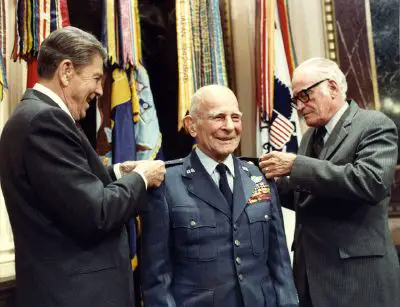
Doolittle married Josephine E. Daniels on December 24, 1917. At a dinner celebration after his first all-instrument flight in 1929, "Joe" Doolittle asked her guests to sign her white damask tablecloth. Later, she embroidered the names in black. She continued this tradition, collecting hundreds of signatures from the aviation world. The tablecloth was donated to the Smithsonian. Joe Doolittle died in 1988, five years before her husband.
The Doolittles had two sons, James Jr., and John. Both became military aviators. James Jr. was an A-26 Invader pilot during W.W. II and committed suicide at the age of 38 in 1958.
His other son, John P. Doolittle, retired from the Air Force as a Colonel, and his grandson, Colonel James H. Doolittle, III, was the vice commander of the Air Force Flight Test Center, Edwards Air Force Base, California.
James H. "Jimmy" Doolittle died in Pebble Beach, California on September 27, 1993, and is buried at Arlington National Cemetery in Virginia, near Washington, D.C., next to his wife. In his honor at the funeral, there were over-flights of the few remaining flyable B-25 Mitchells in the United States, and also of U.S.A.F. Eighth Air Force bombers from Barksdale Air Force Base, Louisiana. After a brief graveside service, one of the Doolittle Raiders tried to play taps in honor of his former commander, but retired Colonel William Bower could manage only a few faltered notes before having to pass the bugle to Doolittle's great-grandson who finished the playing of taps.
Legacy
In 1985, although long retired from active duty, retired Lieutenant General James H. Doolittle became General James H. Doolittle, when President Ronald Reagan and Senator Barry Goldwater pinned on the four-star insignia.
He is the only person to win both the Medal of Honor and the Presidential Medal of Freedom, the nation's two highest honors. In 1983, he was awarded the United States Military Academy's Sylvanus Thayer Award. He was inducted in the Motorsports Hall of Fame of America as the only member of the air racing category in the inaugural class of 1989, and into the Aerospace Walk of Honor in the inaugural class of 1990. The headquarters of the United States Air Force Academy Association of Graduates (on the grounds of the United States Air Force Academy), Doolittle Hall, is named in his honor.
On May 9, 2007, The new 12th Air Force Combined Air Operations Center, Building 74, at Davis-Monthan Air Force Base, Tucson, Arizona, was named in his honor as the "General James H. Doolittle Center." Several surviving members of the Doolittle Raid were in attendance during the ribbon cutting ceremony.
The Society of Experimental Test Pilots annually presents the James H. Doolittle Award in his memory. The award is for "outstanding accomplishment in technical management or engineering achievement in aerospace technology."
The Air and Space Centennial Issue lists Doolittle as number one on the list of the top ten "most important aviators," and a section of the Smithsonian Air and Space Museum is dedicated to him.
Doolittle was portrayed by Spencer Tracy in the 1944 film Thirty Seconds Over Tokyo and by Alec Baldwin in the 2001 film Pearl Harbor, in which a fictionalized account of the Doolittle raid was depicted.
He contributed all of his personal papers including his technical research studies to the University of Texas at Dallas.
Notes
- ↑ Carroll V. Glines, Doolittle's Tokyo Raiders (Princeton, NJ: Van Nostrand Co., 2000, ISBN 978-0442027261).
- ↑ The Perilous Fight PBS ( 2003). Retrieved September 26, 2023.
- ↑ James Harold Doolittle and Carroll V. Glines, I Could Never Be So Lucky Again: An Autobiography (New York, NY: Bantam Books, 1991, ISBN 0553078070).
- ↑ James Harold Doolittle Congressional Medal of Honor Society. Retrieved September 26, 2023.
ReferencesISBN links support NWE through referral fees
- Doolittle, James Harold, and Carroll V. Glines. I Could Never Be So Lucky Again: An Autobiography. New York, NY: Bantam Books, 1991. ISBN 0553078070
- Doolittle Raiders 50th Anniversary Planning Committee. The Doolittle Raiders 50th Anniversary Celebration, April 18, 1992, Columbia, South Carolina: [dedication ceremony program]. Columbia, SC: Doolittle Raiders 50th Anniversary Planning Committee, 1992. OCLC 75545915
- Glines, Carroll V. Doolittle's Tokyo Raiders. Princeton, NJ: Van Nostrand Co., 2000. ISBN 978-0442027261
- Glines, Carroll V. Jimmy Doolittle: Daredevil, Aviator and Scientist. New York: Macmillan, 1972. ISBN 978-0025442108
- Hoppes, Jonna Doolittle. Calculated Risk: the extraordinary life of Jimmy Doolittle, aviation pioneer and World War II hero; a memoir. Santa Monica, CA: Santa Monica Press, 2005. ISBN 1891661442
External links
All links retrieved January 29, 2025.
- Jimmy Doolittle Find a Grave
Credits
New World Encyclopedia writers and editors rewrote and completed the Wikipedia article in accordance with New World Encyclopedia standards. This article abides by terms of the Creative Commons CC-by-sa 3.0 License (CC-by-sa), which may be used and disseminated with proper attribution. Credit is due under the terms of this license that can reference both the New World Encyclopedia contributors and the selfless volunteer contributors of the Wikimedia Foundation. To cite this article click here for a list of acceptable citing formats.The history of earlier contributions by wikipedians is accessible to researchers here:
The history of this article since it was imported to New World Encyclopedia:
Note: Some restrictions may apply to use of individual images which are separately licensed.
